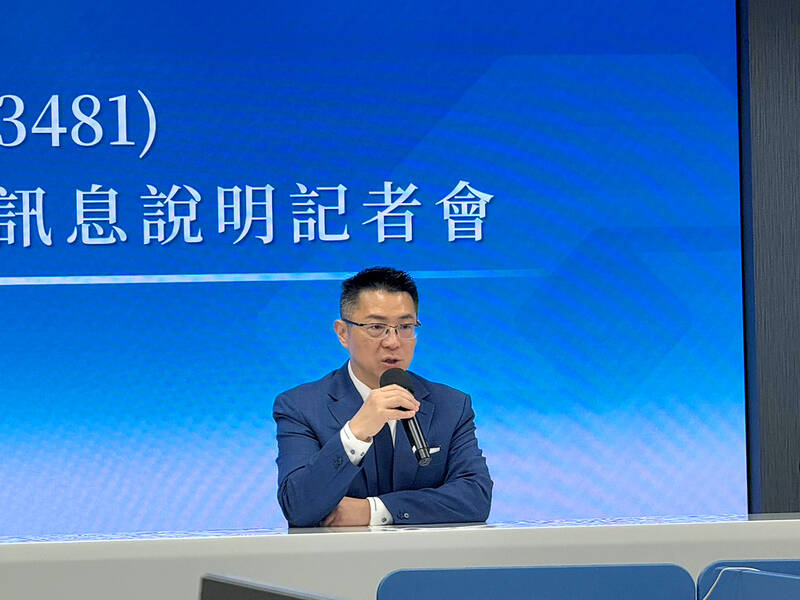Flat-panel display maker Innolux Corp (群創) yesterday said its vehicle display unit, CarUX Holding Ltd, is to fully acquire Japan’s Pioneer Corp in a cash deal valued at about NT$37.7 billion (US$1.3 billion) in a bid to enhance its smart cockpit product lineup for audio and human-machine-interface applications.
Innolux said it has reached an agreement with EQT Partners AB, a global investment firm, to acquire 100 percent of Pioneer shares.
The Japanese firm became a private company after EQT acquired it three years ago.

Photo: Chen Mei-ying, Taipei Times
The strategic acquisition would significantly increase CarUX’s penetration in the Asia-Pacific market and enrich its business portfolios, Innolux and CarUX chairman Jim Hung (洪進揚) told a news conference at the Taiwan Stock Exchange in Taipei.
CarUX is expected to become a tier-one supplier across multiple product platforms, leveraging Pioneer’s strengths in the automotive sound system and human machine interface software developments, Hung said.
By integrating the research and development and manufacturing networks of both companies, CarUX would have better regional capabilities and more agility to serve the evolving needs of global original equipment manufacturers and consumers, he said.
Pioneer has long-term partnerships with major Japanese and global automakers, including Toyota Motor Corp. The company offers a wide range of auto electronics from navigation systems, stereos, audio-video systems and speakers to map software, its Web site says.
The company generated ¥240 billion (US$1.7 billion) in revenue in the fiscal year ending March last year and maintains a healthy financial structure, Hung said.
CarUX plans to arrange a bridge loan and a syndicated loan to fund the acquisition, Hung said.
The deal is not only a capital alliance, but also a strategic synergy between two firms, he said.
The transaction is subject to regulatory approvals and other customary closing conditions. Details of the transaction have not been disclosed.

Taiwan Semiconductor Manufacturing Co (TSMC, 台積電) last week recorded an increase in the number of shareholders to the highest in almost eight months, despite its share price falling 3.38 percent from the previous week, Taiwan Stock Exchange data released on Saturday showed. As of Friday, TSMC had 1.88 million shareholders, the most since the week of April 25 and an increase of 31,870 from the previous week, the data showed. The number of shareholders jumped despite a drop of NT$50 (US$1.59), or 3.38 percent, in TSMC’s share price from a week earlier to NT$1,430, as investors took profits from their earlier gains

In a high-security Shenzhen laboratory, Chinese scientists have built what Washington has spent years trying to prevent: a prototype of a machine capable of producing the cutting-edge semiconductor chips that power artificial intelligence (AI), smartphones and weapons central to Western military dominance, Reuters has learned. Completed early this year and undergoing testing, the prototype fills nearly an entire factory floor. It was built by a team of former engineers from Dutch semiconductor giant ASML who reverse-engineered the company’s extreme ultraviolet lithography (EUV) machines, according to two people with knowledge of the project. EUV machines sit at the heart of a technological Cold

TAIWAN VALUE CHAIN: Foxtron is to fully own Luxgen following the transaction and it plans to launch a new electric model, the Foxtron Bria, in Taiwan next year Yulon Motor Co (裕隆汽車) yesterday said that its board of directors approved the disposal of its electric vehicle (EV) unit, Luxgen Motor Co (納智捷汽車), to Foxtron Vehicle Technologies Co (鴻華先進) for NT$787.6 million (US$24.98 million). Foxtron, a half-half joint venture between Yulon affiliate Hua-Chuang Automobile Information Technical Center Co (華創車電) and Hon Hai Precision Industry Co (鴻海精密), expects to wrap up the deal in the first quarter of next year. Foxtron would fully own Luxgen following the transaction, including five car distributing companies, outlets and all employees. The deal is subject to the approval of the Fair Trade Commission, Foxtron said. “Foxtron will be

INFLATION CONSIDERATION: The BOJ governor said that it would ‘keep making appropriate decisions’ and would adjust depending on the economy and prices The Bank of Japan (BOJ) yesterday raised its benchmark interest rate to the highest in 30 years and said more increases are in the pipeline if conditions allow, in a sign of growing conviction that it can attain the stable inflation target it has pursued for more than a decade. Bank of Japan Governor Kazuo Ueda’s policy board increased the rate by 0.2 percentage points to 0.75 percent, in a unanimous decision, the bank said in a statement. The central bank cited the rising likelihood of its economic outlook being realized. The rate change was expected by all 50 economists surveyed by Bloomberg. The